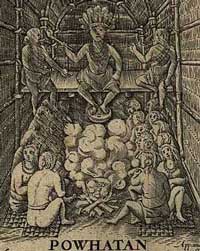c. June 17, 1547 – c. 1618

Powhatan was the leader, or chief, of the Powhatan federation of Indians, a group of some thirty tribes, that occupied Virginia in the early seventeenth century.
His proper name was Wahunsenacawh and he was the father of Pocahontas. The Powhatan (also spelled Powatan and Powhaten) spoke an Algonquian language. The sketch to the right was taken from one of John Smith’s journals.
Location
Powhatan was actually the name of one of the towns where Wahunsenacawh lived, in the east end of the city of Richmond, Virginia. It was also the name of the adjacent river which today is called the James River. When he created a powerful empire by conquering most of Tidewater Virginia, he called himself the “Powhatan”, which is actually a title rather than his given name.
Chief Powhatan was apprehensive about the arrival of English settlers. When Captain Christopher Newport arrived with his three ships, the Chesapeake Indians of the Cape Henry region, drove a landing party back to the ships. About a week after the initial attack, Newport took a small boat up the river on a reconnoitering, get-acquainted mission, stopping at various Indian villages.
It was then that Newport learned that Powhatan ruled the whole area above Jamestown. Thinking that the Chesapeakes who had initially driven them back to the boats were not under Powhatan’s control, Newport attempted to make an alliance against them with a local chief he mistook for Powhatan. Before the Jamestown settlers could complete their fort, 200 Paspaheghs, a tribe of the Powhatans that lived near the juncture of the James and Chickahominy rivers, attacked them, killing onel and wounding eleven other colonists.
Pocahontas & Captain John Smith
During the early years of the English colony, the Powhatans conducted several small-scale raids against the fort. In 1608 Powhatan’s brother, Openchancanough, captured Captain John Smith and brought him back to Powhatan’s main village, Werowocomoco. Powhatan had already become acquainted with Smith in his previous bargaining for corn and other provisions. Smith claimed that he was tried before Chief Powhatan and sentenced to death but that his life was spared by the intercession of Powhatan’s daughter Pocahontas. Some have disputed this account, alleging that Powhatan staged a mock trial and deliberately planned the rescue for his own purposes. Whatever Powhatan’s intentions, he did permit Smith to return to Jamestown.
Powhatan did exhibit some trust of the settler when he allowed his sons and daughter, Pocahontas, to travel to and from the settlement. The English needed the Indians for their corn, venison, and fish. But the relationship was a rocky one. Captain Newport, for example, in a well-intentioned gesture managed to upset the Indians when he decided to stage an elaborate coronation ceremony for Powhatan in an attempt to cement the friendship between the two groups. Powhatan was a proud and respected leader, the equivalent of an English king already.
Powhatan Coronation
Unaware of Indian customs and Powhatan’s high standing among his own people, the settlers added insult to injury by requesting that the coronation take place in Jamestown. Powhatan wanted the ceremony in his own village of Werowocomoco where he ususally received tributes. Newport, Smith and several other colonists traveled to Werowocomoco to take part in the celebration but as it turned out, neither party quite understood what was going on. The settlers thought they were crowning a king while the Indians believed they were receiving tribute from their subjects. Powhatan, in the end, received the gifts sent by King James which included a canopy bed and scarlet cloak.
War
Despite this seeming friendship, Powhatan continued to observe the English warily and his warriors still harassed the colonists with small-scale attacks. Although the colonists eventually planted their own corn, they remained dependent upon the Indians to ensure that they would have enough provisions, especially in the lean winter months. Powhatan continued to trade but his terms became stiffer. By the time Smith left Virginia in 1609, the fragile peace frayed badly, leading to the First Anglo-Powhatan War, and further English expansion beyond Jamestown and into Powhatan’s territory. Two subtribes, the Kecoughtan and the Paspahegh, were effectively destroyed at the beginning of the war, and Powhatan sent the Nemattanew to operate against the English on the upper James River, though they held out at Henricus.
Pocahontas Kidnapped
In 1613, the Englishmen kidnapped his daughter Pocahontas in order to get back some of their own people taken in prior attacks. The settlers offered a prisoner exchange and Powhatan complied but he refused to return the weapons he had stolen. Powhatan ordered the governor to treat his daughter well and seemed content to allow her to remain among the English. Later that same year Pocahontas asked permission from her father to marry the colonist John Rolfe, a leading tobacco planter. Powhatan agreed.
Powhatan Death
Upon the death of Chief Powhatan in 1618, his younger brother Opitchapam officially became paramount chief, however the real regime now effectively belonged to Opechancanough, younger brother to both of them. In the Indian Massacre of 1622, and again in 1644, he attempted to force the English from Virginia. These attempts invited strong reprisals from the English, ultimately resulting in the near destruction of the tribe.
Through his daughter Pocahontas (and her marriage to the English colonist John Rolfe), he was the grandfather of Thomas Rolfe. The Rolfe family is considered one of the First Families of Virginia, one with both English and Native American roots.
Chief Powhatan’s first known chief village, Werowocomoco, is an archaeological site in Gloucester County, Virginia which has been listed as a National Historic Site and Powhatan’s burial mound is allegedly located on the Pamunkey Indian Reservation in Virginia.





